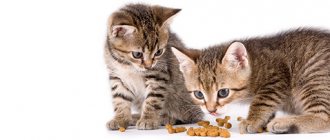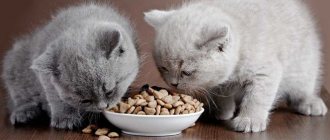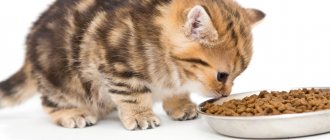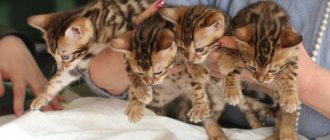In the first month after the birth of small kittens, only the mother cat needs to feed nutritious food rich in microelements. Feeding kittens will add some extra hassle to caring for the litter. For the first 3-4 weeks, newborns need exclusively breast milk. Then the babies begin to be fed and taught nutritious adult food.
Complementary feeding - when to start?
A small pet requires constant attention. If the owner decides to supplement the kitten’s diet, it is necessary to: analyze the health, well-being, and determine the age of the pet. A kitten needs complementary feeding at a certain age; if the animal was bought secondhand or picked up on the street, there is no need to rush to introduce meat into the diet.
The only food a mother feeds her babies for the first month and a half is breast milk. In nature, feeding with mother's milk lasts about two months, but one and a half month old kittens are already starting to try other foods.
The main rule, if you decide to adopt a kitten, is to adopt it at least 8 weeks old.
In this case, the baby will not have to be fed with formula or milk. If you decide to adopt an animal from a friend, you should wait until it grows up.
When a kitten is picked up on the street, it is difficult to independently determine its age. A veterinarian will come to the rescue. It is necessary to take the new family member to the veterinarian to find out the age, check the health, and assess the general condition. Animals taken from the street are often infected with parasites and can suffer from diseases that are dangerous to the human body.
Having determined the age, the veterinarian will advise what food it is time to give the kitten.
If:
- less than a month old - should be fed with formula milk;
- from a month to two - introduce supplementary feeding in the form of solid food;
- more than two months - feed as an adult.
If crumbs are born to a cat already living in the house, you should start feeding them no earlier than after 4 weeks.
It is important to know
- The composition of ready-made feeds includes almost the same set of ingredients, the percentage of which depends on the class of feed, and the digestibility of the feed also depends on it.
- The water must be fresh, so change it several times a day.
- The feeding rate is indicated on the food packaging.
- Pay attention to the age and body weight of the kitten or adult cat, as different manufacturers give different feeding standards. Most kittens reach 75% of their final weight by 6 months, followed by developmental weight gain.
- After 6 months, the young animal can be fed diets intended for adult cats. Because adult cats weigh significantly more than male cats, their growth and development take much longer. Therefore, the transition to feeding for an adult cat will be individual for each individual.
How to artificially feed?
In some cases, a situation arises when a cat refuses to feed newborn kittens, then the owner will have to feed them himself.
The best option is feeding with adapted milk formulas, which are sold in pet stores. Cow's milk and cream with various additives are also suitable.
Popular recipe: mix a glass of cow's or goat's milk at room temperature with vegetable oil (1 teaspoon), raw yolk. Beat, add honey (1 teaspoon).
Algorithm of actions:
- Prepare supplementary food. The daily norm for a newborn kitten is 22-24 ml.
- Divide feeding into 6-7 meals.
- Single dose - 3-5 ml.
- The interval between feedings is at least 2 hours.
At two weeks of age, the time between feedings should be increased by an hour; when the kitten is one month old, the number of feedings should be increased to 4 times.
Advice: for each meal you need to prepare a new portion of food; you can feed it with a pipette or pacifier. The position for breastfeeding is on the tummy.
Help the cat
The pet pleased the owners. Squeaking lumps were born. If the cat has given birth for the first time, the litter should not be too large. From 3 to 6 kids is ideal.
The mother is able to feed this number of kittens normally. If there are more of them, you will have to introduce complementary foods for the kittens, or, more correctly, supplementary feeding.
For these purposes, you can buy a cat's milk replacer. It is sold in good pet stores. It's not cheap, let's warn you right away.
You can make a substitute yourself. It is different from the store bought one, of course. But it has been tested by time and by more than one “cat person.”
- Take a liter of milk.
- Add two yolks to it.
- A teaspoon of sugar also goes here.
- Mix everything.
- Feed the kitten the heated mixture.
How to introduce complementary foods?
Kittens can be supplemented from one month of age.
- Milk porridge made from rice, semolina, and oatmeal is recommended as the first supplement.
- After a few days, you can offer boiled cereal in water, diluted with baby meat food or minced meat.
- During the week, you should increase the percentage of meat in your food, reducing the amount of cereal.
- At 8 weeks it is worth offering pure meat without added grains.
- After 8 weeks, vegetables, crushed to a puree, should be added to the diet.
Up to 4th month
During this period, the feeding method must be adapted to the kitten's anatomy: the kitten's digestive tract is not yet fully developed, but its hunger does not decrease. Therefore, they need many small, regular meals throughout the day. Meal times should always be the same. In the wild, a cat eats 20 small meals throughout the day and night. Ideally, fill your cat's feeder right before bed so that she has food while you sleep.
© shutterstock
Diet for feeding
By the age of one month, babies are teething, their bones are forming, and the body needs more vitamins and nutrients.
You can start complementary feeding, which consists of:
- cereal porridge with milk;
- finely chopped meat;
- boiled eggs;
- masses of cottage cheese, glucose, raw yolks;
- meat baby food.
Feeding should be done every other day, and foods should be introduced gradually in order to stop the possible development of allergic reactions in time.
Third week
Another week passes. The baby is already 21 days old. It's time to think about starting to feed kittens meat.
Previously, it was believed that babies should be given minced meat and porridge in meat broth. Now the position is different. Complementary feeding for a kitten begins with baby food. Of course, it must be meat or meat and vegetables.
Warm up the food a little. Take a teaspoon. We need half a spoonful of nutrition. We bring it to the kitten’s nose. The baby begins to actively sniff, fuss and try to lick the treat. If there is no last attempt, then take a little puree on the tip of your finger. And we pass it over the kitten’s lips. Someone recommends rubbing a treat on his palate, but on his lips - it’s more familiar and calmer. The sky can also be damaged.
Strictly follow the rule: one day - one new dish. There is no need to give your kitten porridge, meat puree and cottage cheese right away. Feed puree on Monday. On Tuesday, cook the porridge, and on Wednesday, give the cottage cheese.
Water in the diet
The right amount of fluid is vital for metabolism. The kitten does not experience an urgent need for additional moisture if it is mother-fed. After offering additional food to your pet, make sure there is enough water in the diet.
Kittens do not like to drink water and may refuse water completely. The solution is to add water to supplementary meals. All food should be liquid in consistency. As an option: place a bowl of water next to the food, and occasionally the kids start drinking water on their own.
Ready-made food for kittens
Ready-made food is available in the form of dry food or wet food - jelly-like mousses, canned food and treats.
As already mentioned, if you do not want to risk your pet’s health, you need to choose premium and super premium food.
Cheaper feeds do not have high quality raw materials and may contain harmful preservatives and dyes, which, when used for a long time, affects the health of the animal.
To feed a kitten from 1 to 4 months, use wet mousses or dry croquettes, which are soaked in water. After 4 months, they switch to dry food; it is useful to combine it with wet food from the same manufacturer - mousses and canned food. Occasionally you can pamper an older kitten with treats.
Important! When feeding dry food, ensure the kitten has constant access to water.
Dry food for kittens
Among super-premium dry food, the following are deservedly popular:
"Royal Canin", "Purina ProPlan", "Iams/Eukanuba".
Premium dry food:
“Hills” (Hills), “Eagle Pack” (Eagle Pak), “Pro Pak” (Pro Pak), “Nutro Natural Choice” (Nutro Natural Choice).
Characteristics that you should pay attention to when selecting high quality feed:
- They do not contain soy, by-products, chemical dyes, preservatives, or odor imitators;
- Meat comes first in the description of the food composition;
- The number of additional ingredients is at least 4-5, usually 8 or more.
Breed characteristics of introducing complementary foods
When compiling a diet, you need to take into account the breed and hereditary factor. Based on the experience of breeders, we can conclude that kittens of some breeds lag behind their outbred peers in development, therefore, feeding is introduced later in time.
According to their development, babies of popular (British, Scottish) breeds can receive additional nutrition as early as 4 weeks after birth.
Maine Coon cubs mature late. The mother feeds the babies until they reach two months of age. Feeding should be introduced no earlier than 8 weeks from birth.
For Sphynx cubs, additional nutrition is introduced from the age of one and a half months. Lack of hair causes the body to expend a lot of energy. Products for supplementary feeding should be high in calories.
General Tips
To ensure your kitten grows up healthy, follow these recommendations:
- One day - one new product. Monitor your baby’s well-being and immediately remove food that is not suitable.
- Feed your animal one type of high-quality dry food, without mixing in cheap options.
- If you notice that your kitten has faded fur or frequent diarrhea, consult your veterinarian. Perhaps he needs vitamins. Buy only those prescribed by your doctor. Do not experiment on your pet!
Google, of course, knows everything. But a good doctor is even more. Take care of your furball as if it were your own child.
Source
What should you not feed?
For newborn kittens the following are prohibited:
- Raw cow's milk, food is difficult to digest in the gastrointestinal tract of a tiny animal.
- Milk diluted with water and complementary foods are not nutritious enough; the baby does not receive the required amount of microelements and vitamins.
- Kefir, fermented baked milk, sour cream, yogurt, the baby’s stomach is not able to digest.
- Sausage, meat, cheese, and other products are harmful to the body of a newborn kitten.
- Minced fish, possible parasitic infection.
Cat milk replacers
The main food for kittens at the age of 3 weeks is still mother's milk. But if babies are raised artificially, the human breadwinner should pay special attention to choosing a suitable milk formula.
Industrial feed
The pet industry offers special dry mixtures containing all the ingredients necessary for infant kittens. According to the attached instructions, immediately before use, a small amount of the mixture is diluted with warm water and mixed thoroughly.
It is recommended to purchase products from well-known companies that guarantee nutritional value, good digestibility and excellent taste:
- Royal Canin Babycat Milk;
- Nutri-Vet Kitten Milk;
- Beaphar Kitty-Milk;
- Kittenmilch cdVet.
Natural dairy products
Many owners prefer to prepare food suitable for feeding 3-week-old kittens at home, believing that this will be healthier for the kittens.
It should be remembered that babies do not particularly like regular cow's milk, having a different taste and smell, and, in addition, it contains 3 times less protein and 2.5 times less fat.
To prepare the nutritional mixture, you can use one of the recipes:
- Combine 200 g of whole cow's and goat's milk, add 2 chicken egg whites, mix thoroughly.
- Pour 0.5 tsp into goat milk (100 ml). oil (it is better to take refined corn) and add half the yolk, mix until a homogeneous consistency is obtained.
- Mix warmed cow's milk (250 ml), bone meal (on the tip of a teaspoon), condensed milk (50 ml, without sugar) and boiled water (25 ml). Then the mixture must be strained well so that there are no lumps and cooled.
- Add a drop of Trivit vitamin complex to natural 9% cream (100 ml).
- Dilute the milk powder in fennel broth until it becomes liquid sour cream, add ¼ part of natural cream.











